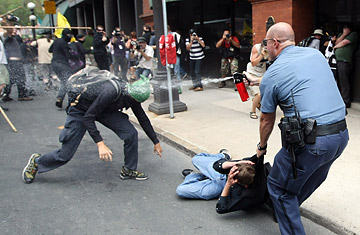
A police officer holds onto one protester while using pepper spray on another during a demonstration march from the Minnesota State Capitol to the Xcel Energy Center in St. Paul, Minn., on Sept. 1
Protest artists had carved large ice sculptures on the capital grounds in St. Paul to read "democracy," to herald their cause and to heckle the Republican National Convention. By the time the demonstrations against the GOP were underway, however, the letters had melted into partisan illegibility, reading "democrat" or "democratic." Protesters later reached the triangular zone across the street from the Xcel Energy Center, where barbed-wire fences and riot police separated the boisterous Republican-bashing crowd from the few delegates inside.
For a few radical demonstrators, the simple presence of GOP delegates was enough to justify throwing bricks through storefronts and a delegate-bus window, lighting a Dumpster on fire, and damaging police cars. Police responded with force, using pepper spray, tear gas and, in some cases, rubber bullets while arresting nearly 300 demonstrators. At least 130 of those arrests were on felony charges, and the National Guard was called to quell violent demonstrators after the main march concluded.
Taken as a whole, however, the march, which drew roughly 10,000 people — 40,000 less than initial estimates — was a peaceful assembly, with the exception of breakaway demonstrators, some of whom are allegedly members of the RNC Welcoming Committee, a self-described anarchist group that was the target of weekend police sweeps. After police and FBI authorities entered suspected Welcoming Committee buildings with battering rams and guns drawn, they confiscated items purportedly used to make Molotov cocktails, along with pipes, smoke bombs, shields, spray paint, bricks, ignitable liquid, maps of downtown St. Paul and even feces and urine, according to one Hennepin County search warrant.
About halfway through the march's route — which stretched through downtown St. Paul from the State Capitol to within shouting distance of the Xcel center — Mike and Sue Starr, 55 and 48, both teachers from Anoka, a suburb here, walked near the front of the protest line, occasionally contributing their voices to the intermittent chants. Mike, a Vietnam veteran who has a son about to leave for Iraq, said he can speak up now that he's retired from 25 years of military service. "We don't support Bush. They won't change, of course, but we're sending a message. Our son just does what he has to do," he says. "We're just here for a peaceful walk. I just hope it stays peaceful."
Five minutes later shots rang out near St. Peter Street, about four blocks from the Xcel center. Several young breakaway demonstrators, with gas masks and bulky backpacks, were seen fleeing the area. Greg Gibbs, 56, a paralegal videotaping the protests for the National Lawyers Guild, called them "just a bunch of kids."
Occasionally throughout the march, demonstrators who were dressed in all black and wearing handkerchiefs and carrying bricks were seen cutting through back alleys and side streets. When the march reached the triangular park, there stood a few dozen brave Republican Party supporters, chanting their approval of the Iraq war. Meanwhile, in the middle of the march line, a group of Industrial Workers of the World bellowed a profane chant while riot police flanked the march, holding sticks and ominous riot guns.
A parachute-sized faux Declaration of Independence held by a dozen marchers was approaching just as an elderly bearded man taunted the riot police by hopping to and fro while hitting his forehead on the sign he was holding. The riot police stared ahead through their shields.
The RNC Welcoming Committee's website informs members not to speak with the corporate media; on Saturday night, when I visited their convergence center, I was met with vehement condemnation. One arrested demonstrator, while waiting to be detained with zipties around his hands, said he did not trust TIME. But on Monday night, with the streets littered with shattered glass and abandoned Dick Cheney masks, Adam, a 19-year-old from Winona, Minn. (like many of his peers, he refused to give his full name), talked about the police raid. He said that after the intense search on Friday he and others conversed with police candidly, trying to be as friendly as possible. "We talked to them like human beings for, like, three hours," he says, rubbing his maced hands. "So that's kind of become my mission; to get my point across and help them understand why I'm here. It's been a really liberating experience."
